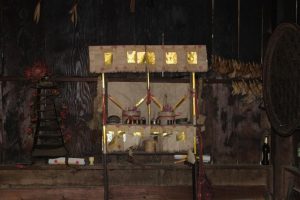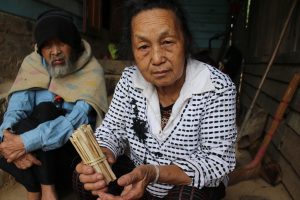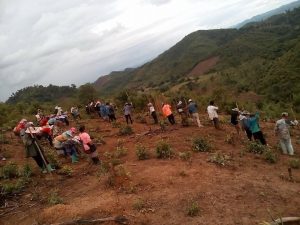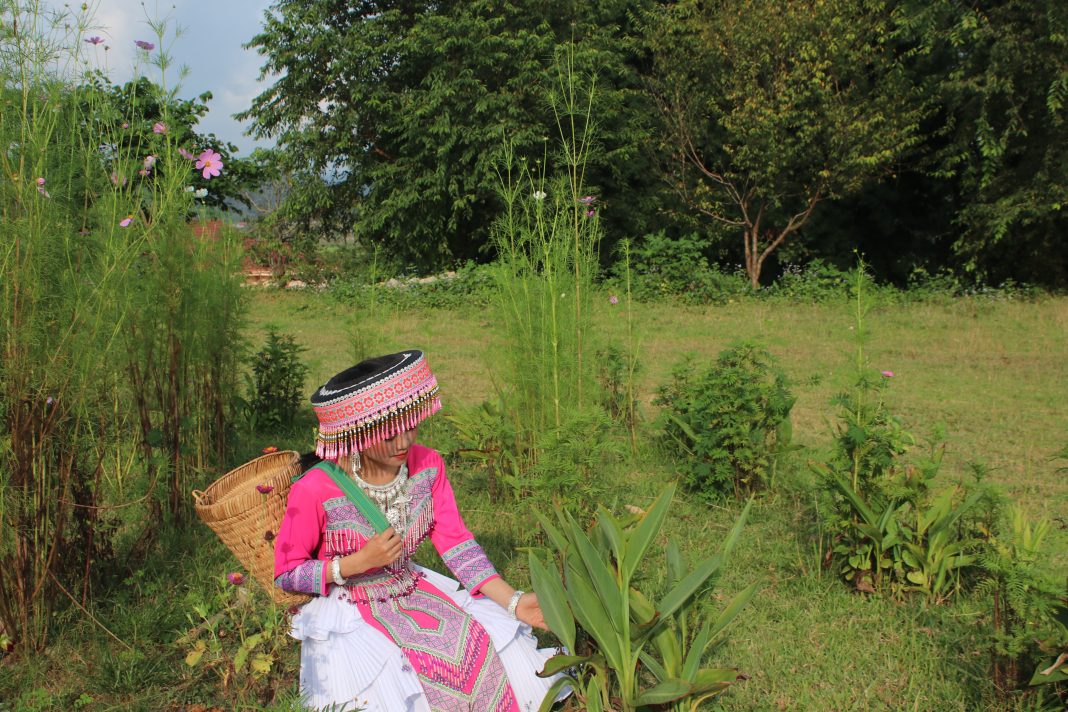Hmong’s traditional medicine and beliefs that preserve nature have been passed down for generations but are now in danger of dying out.
In the highlands of Laos, in remote Pho village in Xieng Khouang province, Mai Lor and her Hmong community believe that severe sicknesses are either weather-related or “soul losses” caused by spirits.
The remedies for both are often combined; one can be treated with medicinal plants or become a shaman.
“My family members’ bodies were like hot coals when they were sick. I needed to boil suav ntism (mugwort) and serve it in food to them as medicine, and after that they were good,” Lor, a Hmong woman in her mid-50s, said while standing in front of her earth-floored wooden home.
Lor often turns to traditional Hmong plants for healing. She uses mugwort to alleviate fevers, sab yeeb (ngai camphor) for body pain and headaches, and nplooj ntse tug (arrowroot) for food poisoning.
She carefully selects specific parts of these medicinal plants to use. From boiling mugwort roots to a steamy arrowroot infusion and a touch of ngai camphor, it’s like a symphony of nature’s remedies. The herbal smells released by the plants are therapeutic when applied to human skin.
According to Hmong beliefs, the txiv neeb (shaman) and the txiv tsuaj (herbalist) are among the most respected members of the community. Such beliefs are deeply rooted in animism, which means all natural resources have souls and should be respected.
Hmong’s spirituality and herbal medicine practice have shaped the community’s relationship with nature and make them the guardians of biodiversity, yet such traditions are at risk of dying out.
Jer Yang, a 75-year-old Hmong shaman and herbalist, has personally experienced the combined power of natural and spiritual remedies. When she fell seriously ill at the age of eight, the villagers believed it was due to a malevolent spirit, which they referred to as a “loss of soul.”
Advised by the community, Jer Yang embraced her role as a shaman in her early thirties.
“It is not easy being a female Hmong shaman. Throughout all my years of being a shaman, many people gossiped or talked behind my back, saying I was not as good as male shamans, even though I tried to help them,” said Yang. “However, that hasn’t stopped me from healing people.”
Illnesses that seem incurable are commonly experienced by Hmong shamans. Many, like Yang, cite their own personal illnesses and subsequent spiritual recovery as key factors motivating them to embrace traditional medicinal and shamanistic practices.
“The recipes for how I cook or find medicine come from my dreams. There will sometimes be spirits or people who tell me what to do or where to find those plants,” said Yang.

Yang described spirits appearing in her dreams, guiding her to select and cultivate forest medicine effectively, emphasizing her intuitive role and her community’s connection with the surrounding environment.
Yang follows specific rituals and beliefs in her practice. Before gathering any plants for medicinal purposes, she seeks permission from the forest spirits. She carefully selects medicinal and non-medicinal plants, ensuring she doesn’t offend the forest spirits by cutting down large trees or hunting wild animals.
“Hmong shamans and herbalists are usually prohibited from killing or hunting animals, particularly wild animals. I sometimes advise my patients not to eat those wild animals, as they can trigger some diseases,” said Yang. “We must be healers, not destroyers.”
A fading tradition
Despite the practice’s importance, elders like Yang and Lor are finding it increasingly difficult to pass their knowledge on to the younger generations, many of whom have migrated to urban areas.
Yang and Lor only finished elementary school, where they were unable to obtain fluency in the Lao language. Knowledge about medicinal plants and the sanctity of nature, therefore, is often passed down orally.
In an English-language classroom in Phonesavanh, three of five Hmong students between the ages of 15 and 18 admitted they knew very little about traditional medicine.
“Traditional medicine is harder to find nowadays, as only the older people know how to use it or find it in the jungle. Having modern medicines at the nearby hospitals and pharmacies is much more convenient,” 13-year-old Nutfasai said.
Yang is concerned about the future of traditional medicine and cultivation, noting that out of her five children, only her youngest daughter is interested in learning about it but is unwilling to take it seriously.
“My main worry is that the younger generation lacks knowledge about cultivating traditional medicine,” she said. “While there are still some who show an interest in learning, there are also those who have abandoned traditional medicine, possibly due to their preference for urban living, which is often detached from nature.”
This concern about the loss of traditional practices and ancient knowledge mirrors Mai Lor’s.
“I cannot write the name of these plants in Lao or Hmong as they were taught in Hmong orally by the elder generation of my family members,” Lor said.
Struggles for a livelihood
Language is not the only barrier to the preservation of herbal practices. These days, even the most committed herbalists are finding it challenging to generate an income from the profession.
To make ends meet, Yang and her community continue to engage in swidden – or slash-and-burn – agriculture, a practice often associated with deforestation and air pollution.

While the surface environmental impacts of slash-and-burn agriculture may seem contradictory to Hmong beliefs, many biologists and anthropologists have argued otherwise.
Researchers have pointed out that this type of agriculture utilizes only a small portion of the forest, which is cleared at any given time. This process benefits the forest’s regeneration and attracts diverse forms of wildlife, as the succeeding fallow period provides favorable conditions for animals.
This farming method, the only livelihood that allows many Hmong women to continue to stay in the region and preserve their herbal medicine practices, however, is often dubbed unsustainable and discouraged by policymakers and the mainstream media.
Yet losing this way of life means more migration to the plains, which leaves the mountainous regions vulnerable to other economic activities and results in a potential loss of biodiversity as guardians like Lor and Yang struggle to survive on their traditional practices.

The seemingly ideal goal of eliminating slash-and-burn cultivation in the name of environmental protection also overlooks the crucial role of indigenous women.
According to the Asian Development Bank’s research titled Women’s Access to Land Forests, and Water, “swidden [agriculture] is the source of biodiversity (which gives life to the forest) and the heart of the ecosystem; the woman is the heart of the swidden, and hence, on one hand, she is the progenitor of the ecosystem, and on the other, the source of human life (childbearing) and sustenance for the family by virtue of the swidden.”
The elimination of this agriculture would raise a significant gender issue, as modern occupations tend to separate them from their traditional ways of life, exposing them to various forms of exploitation and vulnerability.
“We will continue to follow the path that has been our way of life—a balance between medicine and livelihood,” said Yang. “It’s a tradition passed down from those who came before me, and I hope those who come after me will choose it if they do not find success in modern occupations.”
This story was supported by Internews’ Earth Journalism Network.



